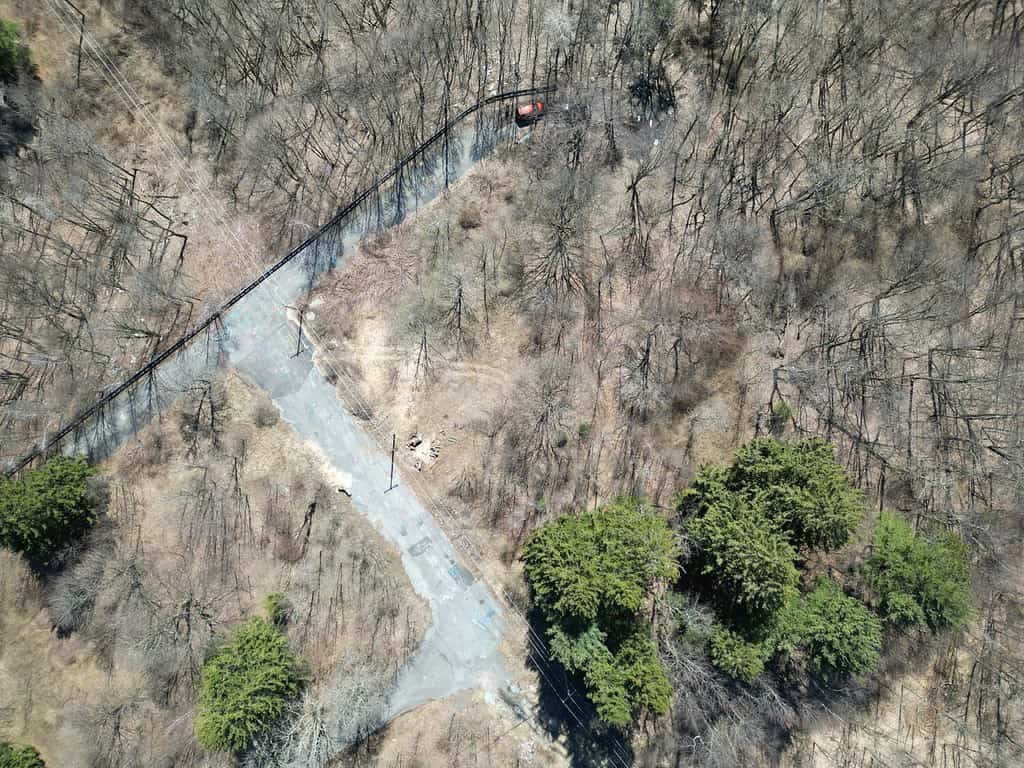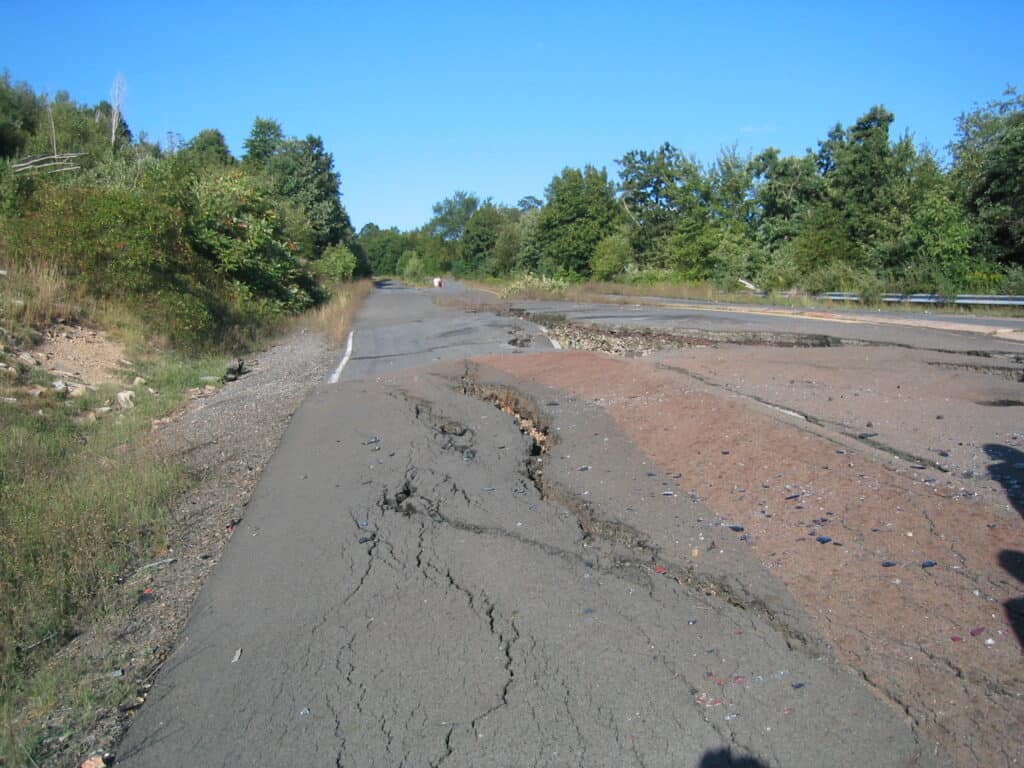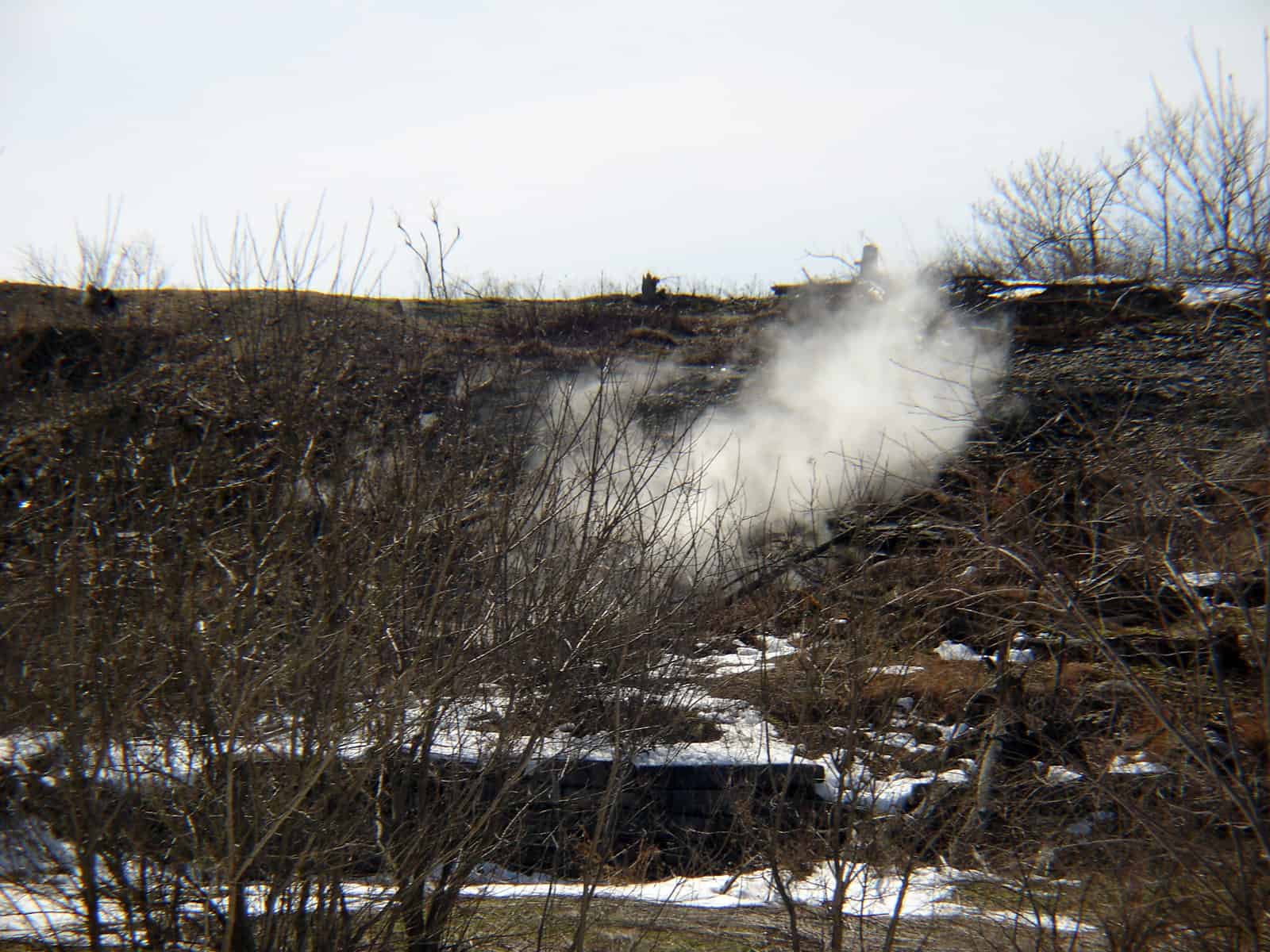We all know what fire looks like – red, orange, yellow, green, purple, and blue flames licking the air in a process of visible combustion. We’ve felt the heat of fires as we stared at them on camping trips, heated our homes with them, and watched them burn down forests. Humans have had a distinct relationship with fire for thousands upon thousands of years – the earliest archaeologically dated common use of fire goes back over 200,000 years! We have myths about fire’s origin, from the Greek Prometheus to the Mazatec legend of Opossum giving fire to humanity.
In Pennsylvania, a fire has been burning for over 60 years. Underneath the borough of Centralia, fire rages on in the labyrinthine depths of abandoned coal mine tunnels.
About Centralia, Pennsylvania

In Pennsylvania, a fire has been burning for over 60 years underneath the borough of Centralia.
©WhiteHotRanch/Shutterstock.com
In 1749, colonists purchased the area that would become Centralia from the Native tribes that inhabited it. Following this purchase, settlers surveyed the area and developed roads that lead to and through it. It would still be several years before the town of Centralia came to be.
In 1793, Robert Morris purchased the land. Does the name sound familiar? Robert Morris was one of the original signers of the Declaration of Independence and a Revolutionary War hero. His ownership of the valley lands of Centralia wouldn’t last long – in 1798, he declared bankruptcy. The Bank of the United States took the lands due to his financial failings. Later, the bank sold the parcel of land, along with 68 additional tracts, to Stephen Girard, a French sea captain. Girard had discovered that these lands were rich with anthracite coal, and he sought to make a fortune on it. Still, it was not until 1854 that the area received attention.
Centralia’s first settler name was Bull’s Head, after the Bull’s Head Tavern that opened in the area in 1832. A decade later, the Locust Mountain Coal and Iron Company acquired the land and this is when the development of Centralia truly began. In 1842, a mining engineer by the name of Alexander Rae plotted out the village and named it Centreville. In 1865, he renamed it Centralia. This choice was based on the prior existence of a town called Centreville. In order to not confuse the Post Office, the town took on its new name and kept it. Centralia achieved incorporation as a borough the next year in 1866.
Now, we jump backward in time to 1854 and the construction of the Mine Run Railroad. This railroad served to transport coal from the valley and played a large role in the short-lived success of the town. The borough owes its existence completely to the very same industry that would lead to its downfall.
Coal Mining in Centralia
As you can see, Centralia focused heavily on the coal mining industry. The first two mines in the area opened in 1856, over 100 years before the fire. These mines, the Coal Ridge Mine and the Locust Run Mine, were the beginning of a largely successful industry. Several other mines opened soon after, and the valley hung its hat on progress pushed by coal mining. By 1865, 5 or more anthracite mines were in constant operation. This led to a boom for the borough – Centralia reached its maximum population in 1890. The less than 3,000 population focused on mining, but citizens also worked at one of the 27 saloons, 5 hotels, or 14 grocery stores in the area. Residents would worship at one of the 7 churches and find entertainment at one of the two theatres.
Crime in Centralia
While it seems that this town had everything going for it, this was not the case. Crime and murder plagued the area – allegedly due mostly to the presence of a dangerous group of people. The Molly Maguires, a group of Irish secret society members, may have lived in the area. The Pennsylvania Historical and Museum Commission speaks on this, saying that historians have not deduced whether this was an organized terrorist group or not. Regardless, we’ll briefly touch on the mission statement of the original group and the actions of the group that followed.
The legend of the Molly Maguires begins in 1840s Ireland. This group focused on the rights of laborers and activism against landlords. The group existing in Pennsylvania is still only a rumor. If they existed, they were a significantly more reactive group than the original Irish society. Whether or not it existed is not as important as the crimes tied to it, including the murder of Centralia’s founder, Alexander Rae. There are several other cases of murder and arson tied to the group in Centralia. The 1860s were rife with fear and death in Centralia, and this led to a Roman Catholic priest by the name of Father Daniel Ignatius McDermott cursing the town following his assault. He claimed that one day the only remaining structure to stand in the borough would be the Roman Catholic Church.
The crimes of the group continued into the late 1870s when alleged leaders and members of the group died by public hanging. Their legend – and the curse offered by the priest – lives on.
The Centralia Mine Fire
Now, we come to the fire that ended Centralia. It is unfortunate that the fire began with good intentions. Worries about illegal dumping in the area called the city council to action. Over 8 illegal landfills surrounded the borough, and the city sought to end illegal dumping. The first course of action, the Centralia Landfill, was somewhat unsuccessful. This landfill opened in 1935 near the Odd Fellows Cemetary and made use of an old strip mine as a site for garbage disposal. The strip mine was 50 feet deep, and the landfill grew to over 300 feet wide and 75 feet long. By 1962, it was a concern for the borough. Landfills built in strip mines are prone to combustion which can lead to mine fires.
The city council proposed and enacted a cleanup, but did not specify the means of doing so. State laws prohibit dump fires. For this reason, it is probable that the city council minutes failed to list the intended procedures for the cleanup.
On May 27th, 1962, volunteer firefighters from the city ignited the fire that would burn for decades. At the end of the burn, they doused the flames with a water hose and called it a day. However, new flames erupted from the site two days later, then a week after that. When the fire kept igniting, investigators looked for the source of the flames. Using a bulldozer, they uncovered a large hole in the base of the pit. This hole created a pathway to the old mines and caused the fire to continue burning.
A month later, on July 2nd, a member of the St. Ignatius Church complained about the foul odor emanating from the dump. Despite this complaint, the Centralia City Council continued to allow garbage dumping at this site to prevent illegal dumping elsewhere. Growing concern about the issue led to new efforts to douse the fire. In the inspections following these efforts, professionals discovered levels of carbon monoxide so high that they surmised it must be a coal mine fire. The cleanup effort had burned out of control.
Several remediation efforts followed, none of them successful, and the fire has been burning ever since.
Other Possible Causes
It is not certain that the organized burn was the cause of the fire. Many hypotheses exist concerning the cause, including previous fires in the area. Some legends claim that the fire had been burning for several years before the planned burn. At this point, it has ceased to matter how it started. The fire has taken the last of the industry and life that exists in the area, and most of Centralia now stands as a ghost town.
Impact of the Fire

The heat from the Centralia mine fire has warped roads and changed the shape of the ground around the borough.
The coal mine fire has deeply impacted the area. The largest immediate impact is on the town itself. Centralia stands nearly empty, with a census-reported population of 4 as of 2021. There are several dangers that keep people from living there, including a deeply increased health risk from the fire’s fumes.
Additionally, the ground around the sites of the fires is unstable and likely to collapse. After all, the fires are burning through expansive mining tunnel systems that burrow around and under Centralia. The heat from the blaze has warped roads and changed the shape of the ground around the borough, making most of the area unlivable.
How Long Will the Fire Burn?
First, there is no way to put out the Centralia mine fires. The area is too dangerous to navigate and the fires are too deep and hot. Efforts to extinguish the fire at this point would be in vain and risk the lives of anyone who tried. The fire has plenty of fuel – it continues to burn through the coal supply that remains in the expansive underground mines. Experts suggest that this fire will continue to burn for at least 250 more years.
Centralia’s Famous Graffiti Highway

The Graffiti Highway, an almost mile-long stretch of highway outside of Centralia, gained cult popularity in the early 2000s.
©Codyrt, CC BY-SA 4.0, via Wikimedia Commons – Original / License
The Graffiti Highway, an almost mile-long stretch of highway outside of Centralia, gained cult popularity in the early 2000s. This section of highway once belonged to Highway 61 before it was abandoned for a safer route through the town. This strip of the highway was formally closed in 1993, but visitors to the area still accessed it all the way up to 2020.
In the early 2000s, the small piece of pavement became a hub for artists and anarchists. Many visitors hailed it as a sort of free space for expression and community. Daring visitors made their marks on the pavement and on surrounding guardrails and even trees, and some burned fires late into the night, sharing stories, songs, and a sense of some sort of freedom. At first, these visits didn’t seem to bother anyone. However, increased traffic to the area was cause for concern for locals, who called for increased patrols of the area.
In 2020, during the first days of the COVID Pandemic, the highway’s legacy came to an end. A mining and metals company acquired the remaining highway and much of the land surrounding it in 2018, and in April 2020, the company covered the road with thousands of tons of dirt. The burial process took three days. Over 400 dump trucks came to the site and covered the colorful art and graffiti. The company’s reasoning was based on liability. The dangers of the area are extensive and they did not want to bear the responsibility of visits like the ones that had occurred during the previous 20 years.
Many people still mourn the disappearance of the road, from anarchists and artists to ghost hunters and record-keepers. Luckily, the legacy lives on in history and photography, and it is unlikely the graffiti highway will be forgotten any time soon.
A Modern Ghost Town
Some remnants of the town and its history still remain. They make up a barren, haunted place with very few landmarks remaining. In 1983, Congress appropriated over 40 million dollars to buy the remains of the town and demolish them. This money also contributed to relocation efforts for the remaining residents.
The Commonwealth of Pennsylvania owns the remaining parts of the borough. The last residents are, in a word, squatters. A long legal battle over the Congressional relief compensated remaining residents for their homes and land and allowed them to remain in them until they die. That said, these remaining few residents do not own the houses they live in and cannot sell them. The Commonwealth of Pennsylvania holds the deeds and plans to demolish the homes when the last residents leave or die.
Cars still pass through the quiet borough on local highways, breathing last life into the region. Only a few buildings still stand, along with the remnants of the cemetery. The United States Postal Service no longer operates in Centralia and has revoked the ZIP code for the town.
Can I Visit Centralia?
The Pennsylvania Department of Environmental Protection strongly recommends steering clear of Centralia. They claim there is a very high risk of danger in the form of injury and death. Noxious fumes and sudden collapses are two of the largest concerns for safety. Some people are willing to bear the risk, stating that no deaths have occurred as a direct result of the fires. However, the danger is still extensive and present.
The cautionary tale that moved most residents from the town is as follows. 12-year-old Todd Dombowski became trapped in a sinkhole caused by the fires on Valentine’s Day of 1981. In a matter of seconds, he was up to his neck in warm mud, surrounded by deadly gasses. He narrowly escaped with his life, leaving behind an extensive sinkhole with temperatures exceeding 350 degrees.
Despite this, it is still possible to visit Centralia. Highways 61 and 42 run directly through the town, carrying thousands of passenger cars daily. Some people do still stop to look at what remains of the town – mostly empty streets and ‘No Trespassing’ signs. Stop at your own risk if you go and don’t linger. Exploration of the area, once again, is dangerous and ill-advised, along with sometimes being illegal. Because of all of these factors, we will not include a map of the area. Visiting the area is at your own risk, and we urge you to do extensive personal research if you’re planning a visit.
Thank you for reading! Have some feedback for us? Contact the AZ Animals editorial team.








